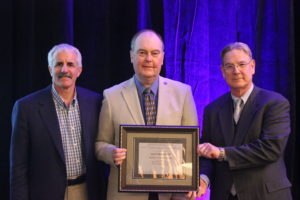For centuries, blueberries were gathered from the dense forests and bogs by Northeastern U.S. Native Americans, and are one of the only fruits we consume that are native to North America. So when most of us hear about blueberry farms, we conjure up images of cool, damp climates and cold winters.
Except on Jimmy Miller’s blueberry farm, which is located in Interlachen, Florida. Miller has operated the farm, which is the oldest existing blueberry farm in the state, since 1979. Miller, along with his two daughters and son-in-law, operates the 124 acre operation using a variety of blueberry developed by the University of Florida that tolerates the summer heat and mild winters.
One of the main issues for blueberry growers in Florida, Miller explains, is that they must have at least 200 hours every winter where the temperature goes below 45 degrees in order for the bushes to flower, and fruit, later that spring. Lack of enough cool days can mean very low fruit production the following year.
The Millers sell their blueberries, which are among the first in the nation to ripen each year, to both national and international fresh fruit markets. While they are relative newcomers to the blueberry market, they have been dealt quite the lucky hand by Mother Nature. That is, until early spring, 2012.
“We never had a real loss until this year,” said Miller, who explained that their primary risk is a freeze or hail. “And the way we manage freeze is with overhead water protection,” he explains, which protects the bushes by allowing a layer of ice to form on the plants and the berries, keeping the plants warmer than the outside air.
Florida, like much of the rest of the country, had a very early spring in 2012, which resulted in the bushes pushing out new growth and eventually blossoming several weeks earlier than usual. “The plants become vulnerable in late January or early February, and then the berries start to form,” Miller noted.
“It was an early spring, and then all of the sudden, we had a front blow through that dropped our temperature to 24 degrees,” he explained. That usually wouldn’t be a huge problem, given the sprinkler system, but this freeze was accompanied by 15 to18 mile per hour wind gusts, which made the water evaporate as quickly as you spray it.
“When water evaporates, it cools the plants, and we were trying to warm them,” he said. “We had plants that were vulnerable because they were in full growth, and then we had the wind,” he added. “The second night, the temperature actually got down to 18 degrees, but we were fine because we didn’t have the wind.”
The next day, the Miller clan was hopeful that it would be ok, “but we also knew that it could be catastrophic,” he said. Miller explained that one of the risk management strategies they have employed is the use of different varieties of plants that have different cold tolerances and will go into bloom at slightly different times.
The problem was, the bushes that should have fared well with the cold snap didn’t fruit fully that year because the mild winter had not met the requisite number of cool days. “And the plants that did put out a good amount of flowers were severely damaged by the freeze and accompanying winds,” he said.
Thankfully, for Miller, he always purchases crop insurance, and if the blueberries didn’t look better in a few weeks, this could be his first crop insurance claim. After the cold snap ended, Miller called his crop insurance agent who came out for an initial assessment.
“When you feel like it looks pretty bad, you need to give your agent notice,” said Miller. As the agent came out to inspect the bushes, Miller noted that “initially, as the plants came out of the cold snap, we were all hopeful.”
But hope wasn’t enough. As the season progressed, it became apparent that the losses would be staggering. “Without crop insurance, it would have been bad, real bad,” said Miller. In the end, the blueberry farm suffered a seventy percent loss.
“I would have been forced to borrow money just to get through the next year,” said Williams, explaining that without crop insurance, he would have to go to a bank and ask for a loan just for operating capital for the year. “And then two bad years in a row, and you are really out on the ledge,” he said.
“This is a tool, a necessary tool,” he said of crop insurance. “You can’t absorb this kind of loss, so you need to have a tool in place to transfer some of the risk to a private company.”
Luckily, the blueberry bushes appear to be recovering in the warm Florida sunshine and Miller is optimistic about his family’s and his farm’s future. “I feel like we’re going to be fine,” he said.














